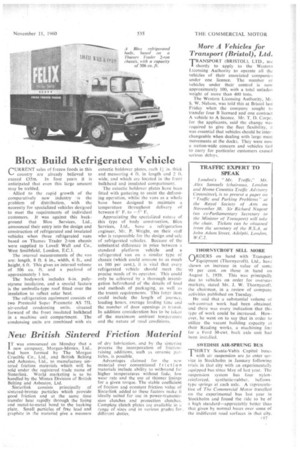Blox Build Refrigerated Vehicle
Page 57

If you've noticed an error in this article please click here to report it so we can fix it.
CURRENT sales of frozen foods in this country are already believed to exceed £35m. In four years it is anticipated that even this large amount may be trebled.
Allied to the rapid growth of the comparatively new industry -is the problem of distribution, with the necessity for specialized vehicles designed to meet the requirements of individual customers. It was against this background that Blox Services, Ltd.. announced their entry into the design and construction of refrigerated and insulated vehicles when three refrigerated vans based on Thames Trader 2-ton chassis were supplied to Lovell Wall and Co., West Smithfield, London, E.C.1.
The internal measurements of the van are: length, 8 ft. 6 in., width, 6 ft., and height, 6 ft. This gives an internal volume of 306 cu. ft. and a payload of approximately I ton.
The bodywork includes 6-in, polystyrene insulation, and a special feature is the umbrella-type roof fitted over the insulation to reflect solar heat.
The refrigeration equimnent consists of two Prestcold Super Presmetic AS 75L air-cooled condensing units, situated forward of the front insulated bulkhead in a machine unit compartment. The condensing units are combined with six eutectic holdover plates, each 11 in. thick and measuring 4 ft. in length and 2 it. wide, and which are located in the front bulkhead and insulated compartment.
The eutectic holdover plates have been fitted with guttering to assist the defrosting operation, whilst the vans as a whole have been designed to maintain a temperature throughout delivery of between 0° F. to —5° F.
Appreciating the specialized nature of this type of body construction, Blox Services, Ltd., have a refrigeration engineer, Mr. P. Wright, on their staff who is responsible for the design and sale of refrigerated vehicles. Because of the Substantial difference in price between a standard platform vehicle and a refrigerated van on a similar type of chassis (which could amount to as much as 100 per cent.), it is vital that every refrigerated vehicle should meet the precise needs of its operator. This could only be achieved by a thorough investigation beforehand of the details of load and methods of Packaging, as well as the transit requirements. This latter item could include the length of journey, loading hours, average loading time and the number of door openings in transit. In addition consideration has to be taken of the maximum ambient temperature and the nature of road conditions.
















































































































































